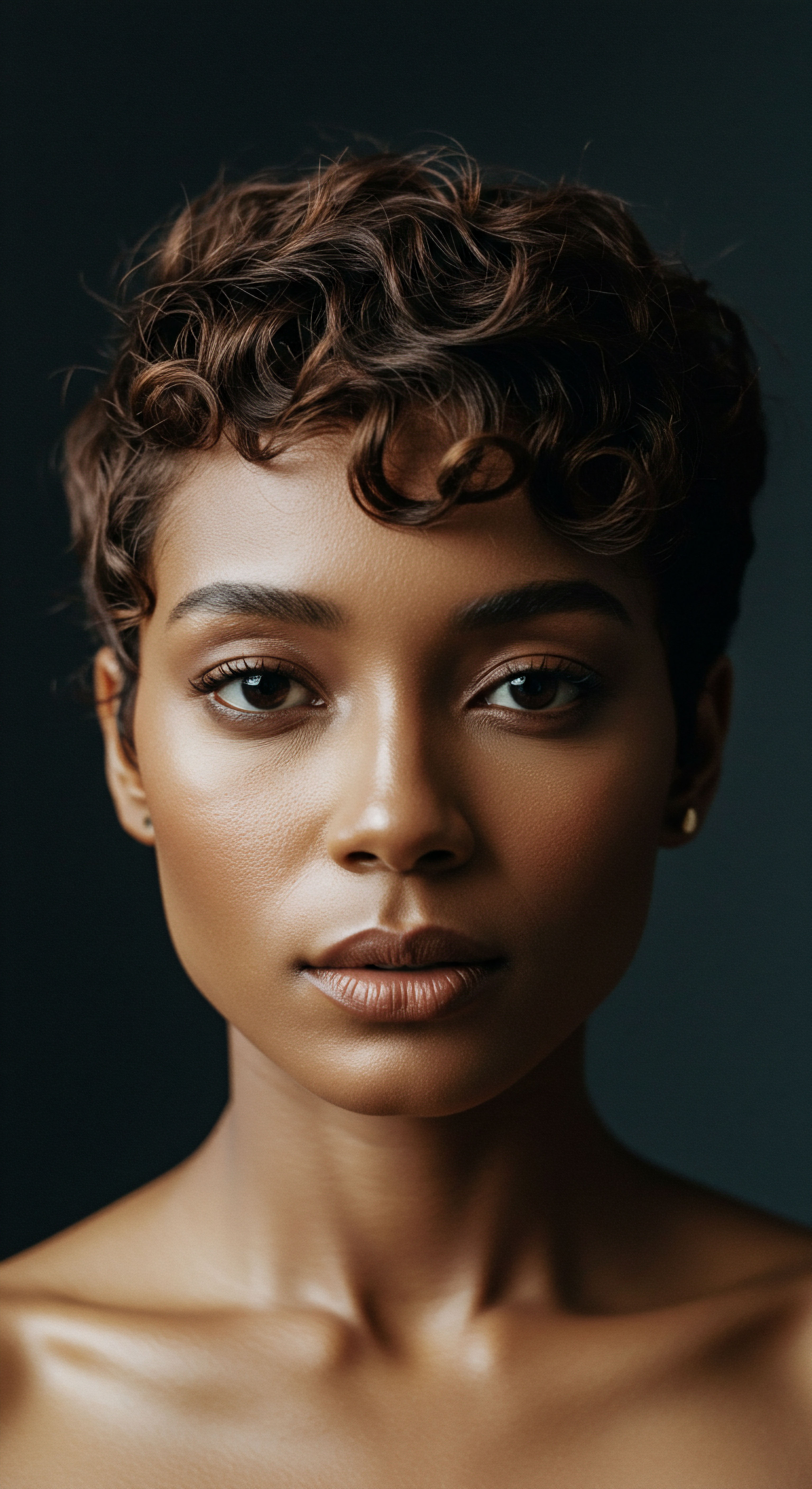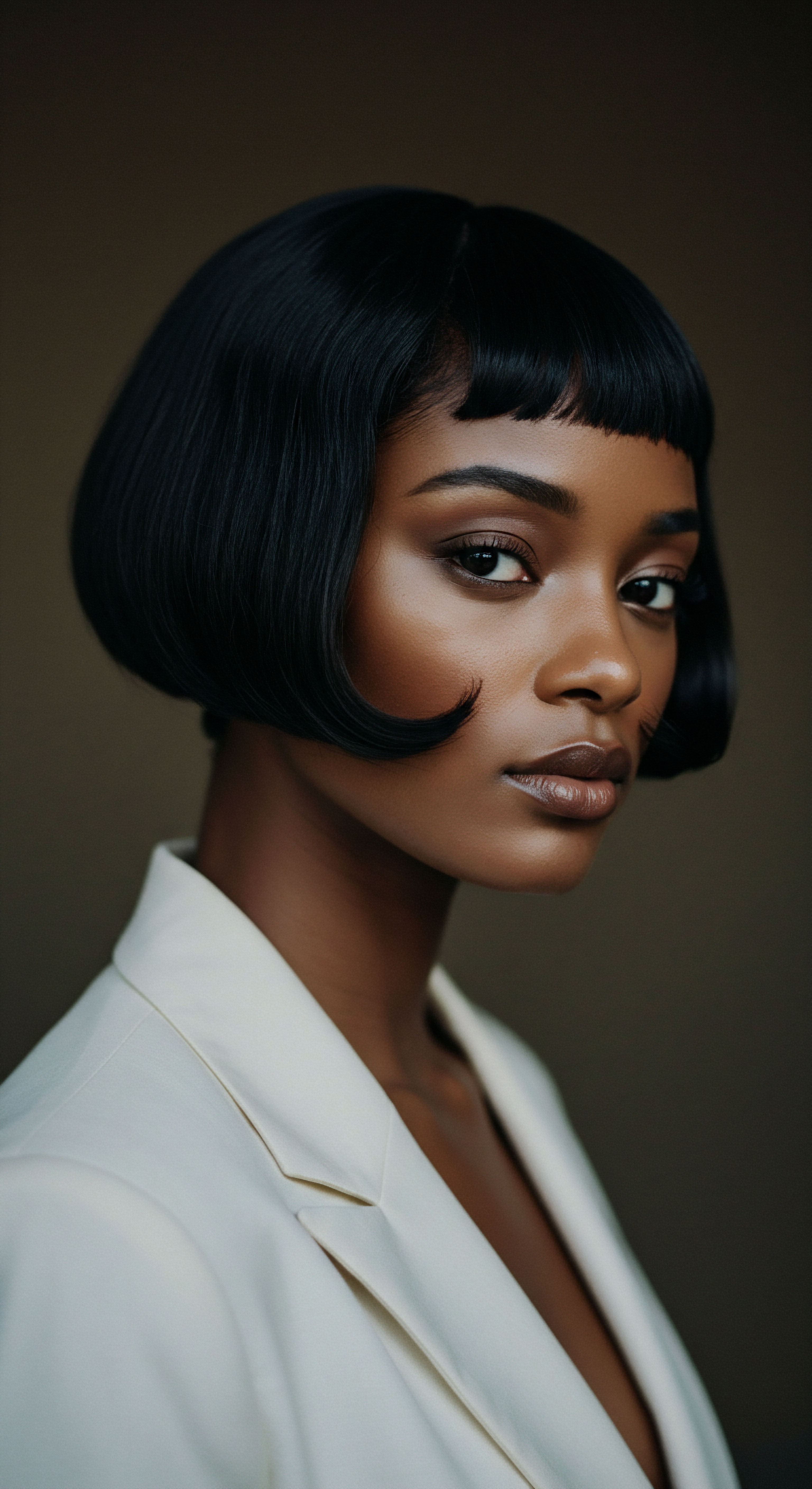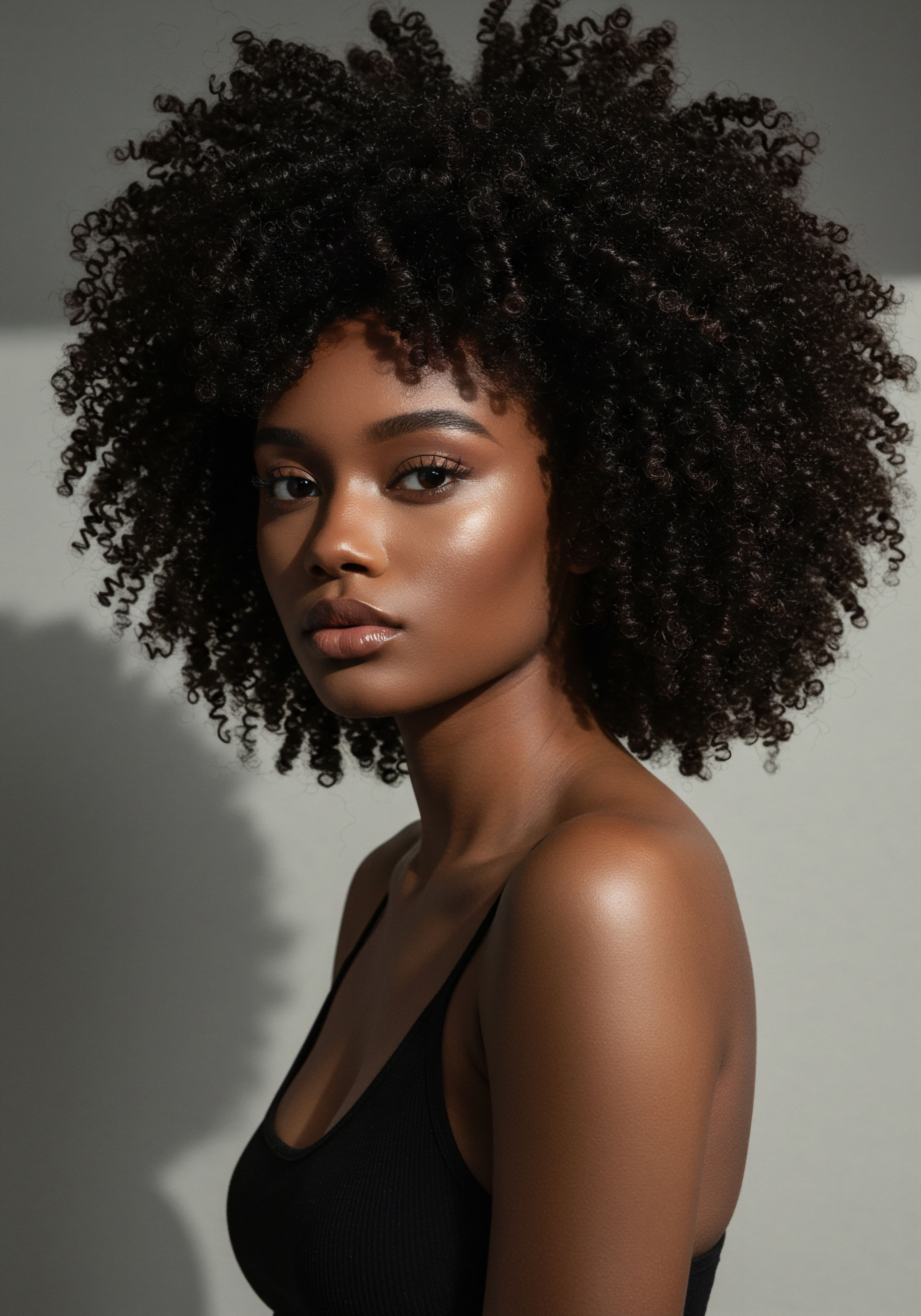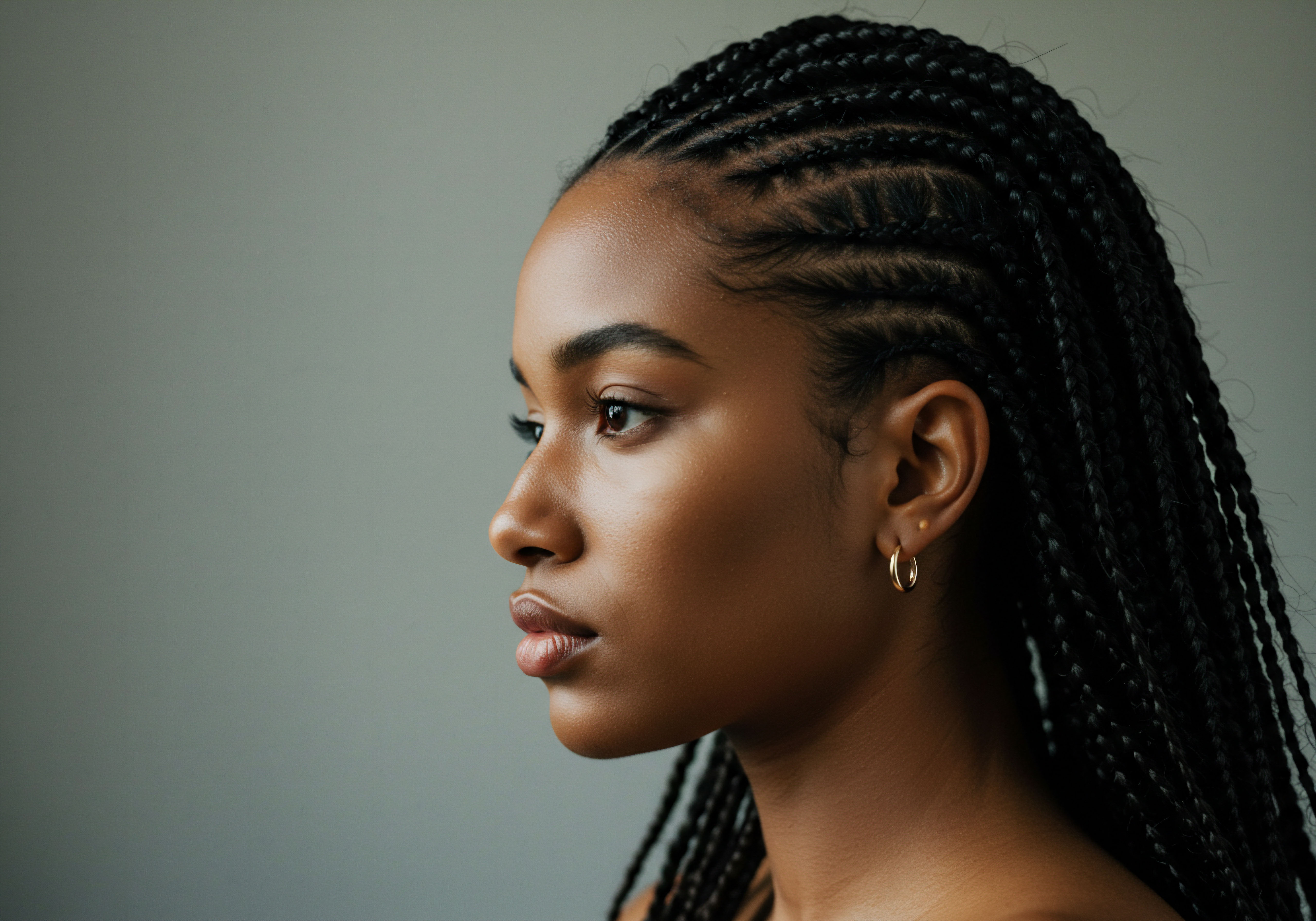
Roots
A quiet curiosity often stirs within us when we consider the enduring beauty of textured hair. It holds within its very structure echoes of resilience, stories whispered across generations, and a profound connection to the earth itself. Our journey into aligning ancestral practices with modern textured hair care begins not with a simple list of ingredients, but with a deeper acquaintance with the hair that crowns us.
This foundational understanding, much like the roots of a grand tree, grounds our approach, allowing us to see our strands not as a challenge, but as a living legacy, deserving of gentle wisdom and informed attention. It is a path towards recognizing the inherent intelligence within each coil and kink, and how ancient wisdom, often born of necessity and a deep connection to nature, provides enduring lessons for contemporary well-being.

Hair Anatomy and Physiology
To truly appreciate ancestral care, one must first understand the unique architecture of textured hair. Unlike straight strands, which typically possess a circular cross-section, coily and kinky hair exhibits an elliptical or even flat cross-section. This distinctive shape, combined with fewer disulfide bonds distributed unevenly along the strand, contributes to its remarkable elasticity and curl pattern. However, it also renders textured hair more susceptible to dryness and breakage.
The cuticle layers, those protective scales that lie flat on straight hair, tend to be more lifted and open on textured strands, allowing moisture to escape more readily and making it more vulnerable to external stressors. This anatomical difference is not a flaw; it is a characteristic that demands a specific, nurturing approach, one that ancestral methods inherently understood.
The follicular structure also plays a significant part. The hair follicle, the tiny organ from which each strand grows, is often curved in textured hair. This curvature means the hair shaft itself undergoes more twists and turns as it emerges from the scalp, creating points of weakness along its length.
These natural bends are where breakage often occurs, especially when hair is handled roughly or when moisture levels are inadequate. Understanding these intrinsic qualities helps us appreciate why ancestral methods often emphasized gentle manipulation, protective styling, and consistent moisture replenishment – practices that directly counter the structural predispositions of textured hair.

Textured Hair Classification Systems
While modern classification systems like the Andre Walker typing chart (1A to 4C) offer a descriptive shorthand for curl patterns, it is helpful to remember that these are relatively recent constructs. Ancestral communities understood hair diversity through observation and experience, recognizing the spectrum of textures within their populations without needing rigid categorizations. Their practices were often adaptable, based on the hair’s observable qualities – its thirst, its tendency to tangle, its strength, or its softness.
The modern typing system, though useful for product selection, can sometimes inadvertently create divisions or hierarchies. A deeper understanding recognizes that within each type, there exists a vast range of porosity, density, and strand width, all influencing how hair responds to care. For instance, two individuals with 4C hair might have vastly different needs if one has low porosity and the other high porosity.
Ancestral wisdom often focused on these more nuanced qualities, observing how hair felt and behaved, rather than strictly adhering to a visual curl pattern. This holistic observation allowed for personalized care long before the term “personalized regimen” gained currency.

The Essential Lexicon of Textured Hair
To speak meaningfully about textured hair, a shared vocabulary becomes essential. Terms like Porosity, which refers to hair’s ability to absorb and retain moisture, or Density, indicating the number of individual hair strands on the scalp, are fundamental. Understanding these concepts allows us to decode why certain ancestral practices, such as applying oils to seal moisture or using specific botanical rinses, were so effective.
- Porosity ❉ This determines how well hair absorbs and holds moisture. Low porosity hair, with tightly bound cuticles, resists water, while high porosity hair, with raised cuticles, absorbs quickly but loses moisture just as fast.
- Density ❉ The measure of how many individual hair strands grow from the scalp. High density hair may appear thick, while low density hair may seem sparse, regardless of strand thickness.
- Elasticity ❉ Hair’s ability to stretch and return to its original state without breaking. Good elasticity indicates healthy, well-hydrated hair.
These terms provide a framework for articulating hair’s specific needs, bridging the gap between ancient observational knowledge and contemporary scientific understanding. They help us translate ancestral techniques into a modern context, ensuring we apply them with precision and purpose.

Hair Growth Cycles and Influencing Factors
Hair growth follows a cyclical pattern ❉ anagen (growth), catagen (transition), and telogen (resting). For textured hair, the anagen phase, though variable among individuals, can be shorter than in other hair types, which influences overall length retention. External factors, such as diet, stress, environmental pollutants, and mechanical damage, profoundly influence these cycles.
Ancestral practices often addressed these external influences holistically. Traditional diets rich in nutrient-dense foods, the use of calming herbs for stress, and protective styling to minimize mechanical damage all contributed to supporting healthy hair growth and retention.
For example, a study in the International Journal of Dermatology (2017) highlighted that chronic traction, often from tight hairstyles, can lead to a condition known as Traction Alopecia, disproportionately affecting individuals with textured hair. While modern styling trends can sometimes exacerbate this, many ancestral protective styles, when properly executed, minimized tension on the scalp and hair follicles. This distinction underscores the importance of not just adopting a style, but understanding the underlying principles of hair health that ancestral practices often upheld.
Understanding the inherent structure of textured hair and its growth cycles is the first step towards appreciating the profound wisdom embedded in ancestral care methods.

Ritual
Moving beyond the fundamental characteristics of textured hair, we now turn our attention to the tangible practices, the very movements and applications that formed the daily and weekly rituals of ancestral hair care. These were not merely acts of grooming; they were often moments of connection, of self-care, and of communal bonding. The wisdom embedded within these rituals speaks to a deep, intuitive understanding of hair’s needs, an understanding that finds remarkable alignment with modern scientific insights into textured hair health. This section delves into the practical application of this wisdom, exploring how ancient techniques and tools continue to hold relevance in our contemporary routines, offering a gentle guide to nurturing our strands.

Protective Styling Principles
One of the most striking alignments between ancestral practices and modern textured hair care lies in the concept of Protective Styling. Across various cultures, from ancient African kingdoms to Indigenous communities in the Americas, styles that tucked away or braided hair were commonplace. These were not just aesthetic choices; they served a crucial purpose ❉ shielding delicate strands from environmental stressors, reducing mechanical manipulation, and promoting length retention. Braids, twists, and various forms of updos minimized exposure to sun, wind, and friction, which can strip moisture and cause breakage.
Consider the intricate braiding traditions of West Africa, where styles like cornrows and individual braids have been passed down through generations. These styles, when installed with appropriate tension, protect the hair shaft from daily wear and tear. Modern textured hair care advocates these same principles, recommending styles that reduce the need for daily detangling and styling, thereby preserving the hair’s integrity. The continuity of this practice speaks volumes about its timeless efficacy.

Natural Styling and Definition Techniques
Ancestral communities often utilized natural ingredients and simple techniques to enhance and define their hair’s inherent curl patterns. Rather than attempting to alter texture, the focus was on working with it, allowing its natural beauty to shine. Techniques involved the careful application of plant-based gels, oils, and butters to clump curls, reduce frizz, and impart a healthy sheen. For instance, the use of flaxseed or okra mucilage, now popular in modern DIY hair recipes, mirrors ancient practices of using natural viscous substances for hold and definition.
The concept of Finger Coiling or gently manipulating wet hair to encourage curl formation, though not explicitly documented in ancient texts, reflects an intuitive understanding of how to encourage hair’s natural tendencies. This gentle approach, combined with the use of nourishing botanicals, allowed for hair to dry in its most defined and moisturized state, a principle still central to wash-and-go routines today.

Herbal Infusions and Cleansing Methods
Ancestral cleansing rituals often involved far more than just water. Various plant-based ingredients were used to gently cleanse the scalp and hair without stripping natural oils. Examples include saponin-rich plants like shikakai or reetha from Ayurvedic traditions, or soapwort in European folk practices. These natural cleansers offered a milder alternative to harsh modern sulfates, preserving the hair’s delicate moisture balance.
| Ancestral Botanical Shikakai (Acacia concinna) |
| Region of Origin India |
| Key Hair Benefit Gentle cleansing, conditioning |
| Modern Product Parallel Sulfate-free shampoos, co-washes |
| Ancestral Botanical Rhassoul Clay |
| Region of Origin Morocco |
| Key Hair Benefit Detoxifying, softening, mineral-rich |
| Modern Product Parallel Clay masks, clarifying treatments |
| Ancestral Botanical Yucca Root |
| Region of Origin North America |
| Key Hair Benefit Mild cleansing, scalp soothing |
| Modern Product Parallel Natural shampoos, scalp treatments |
| Ancestral Botanical Hibiscus Flowers |
| Region of Origin Various Tropical |
| Key Hair Benefit Hair conditioning, strength |
| Modern Product Parallel Botanical conditioners, hair teas |
| Ancestral Botanical Many traditional cleansing agents offered conditioning benefits alongside purification. |
Beyond cleansing, herbal infusions were widely used as rinses to condition, add shine, and address scalp concerns. Rosemary, nettle, and horsetail, steeped in water, provided nutrient-rich washes that stimulated the scalp and strengthened hair. This practice aligns perfectly with modern hair teas and scalp tonics that aim to nourish the follicular environment and promote healthy growth.
The intentionality of ancestral hair rituals, from protective styling to botanical rinses, offers a profound blueprint for contemporary textured hair care.

Relay
Having explored the foundational aspects of textured hair and the practical wisdom embedded in ancestral rituals, we now ascend to a more comprehensive understanding. This segment delves into the intricate interplay of biological, psychological, social, and cultural factors that shape our hair experiences, revealing how ancestral practices are not merely historical curiosities but deeply relevant solutions for contemporary challenges. How do these ancient ways speak to the modern complexities of hair health and identity, particularly for textured hair? We consider the profound resonance of these traditions in a world often disconnected from its natural rhythms, offering a profound understanding that extends beyond superficial care.

Holistic Influences on Hair Health
Ancestral hair care was rarely compartmentalized. It was part of a larger holistic system of well-being, where hair health was seen as a reflection of internal vitality. Diet, spiritual practices, community support, and environmental harmony all played a role.
Modern science increasingly corroborates this interconnectedness. Nutritional deficiencies, chronic stress, and systemic inflammation, for example, are known contributors to hair thinning and loss.
Consider the role of specific foods. Many ancestral diets were rich in micronutrients essential for hair growth ❉ iron from leafy greens, zinc from legumes, and biotin from nuts and seeds. The intentional consumption of these foods, often part of traditional agricultural cycles, inherently supported robust hair.
This aligns with modern trichology, which often recommends dietary adjustments and supplements to address hair concerns. The wisdom was not about a specific hair product, but about a lifestyle that supported health from within.

The Nighttime Sanctuary Protecting Strands
The practice of protecting hair during sleep is a powerful ancestral legacy that holds immense relevance today. For centuries, various cultures utilized head coverings – from silk scarves in parts of Africa to intricately wrapped turbans in the Middle East – to shield hair from friction, tangling, and moisture loss during rest. This seemingly simple act prevents mechanical damage, preserves hairstyles, and maintains hydration, especially crucial for the delicate structure of textured hair.
Modern hair care, recognizing the value of this tradition, champions silk or satin bonnets and pillowcases. These materials reduce friction significantly compared to cotton, which can absorb hair’s natural oils and create microscopic tears on the cuticle. The consistent use of sleep protection, a direct continuation of ancestral foresight, contributes meaningfully to length retention and overall hair integrity. This deliberate act transforms the night into a period of restorative care, rather than one of potential damage.
- Silk Bonnets ❉ Provide a smooth surface that reduces friction, preventing breakage and preserving moisture.
- Satin Pillowcases ❉ Offer similar benefits to bonnets, minimizing tugging and frizz during sleep.
- Loose Braids or Twists ❉ Prior to covering, these styles prevent tangling and further protect strands from manipulation.

Ingredient Deep Dives for Textured Hair Needs
Ancestral practices were inherently sustainable, relying on locally available botanicals and natural resources. This led to a profound understanding of specific ingredients and their benefits for hair. Oils like shea butter, coconut oil, and argan oil, used for millennia in their respective regions, are now global staples in textured hair products. Their emollient properties, rich in fatty acids and vitamins, provide deep conditioning and protection.
Similarly, mucilaginous plants like aloe vera and slippery elm, valued for their detangling and moisturizing capabilities, find their way into modern formulations. The ancestral wisdom lay in observing the plant’s properties and applying them directly. This direct, often unprocessed approach bypassed the need for complex chemical formulations, demonstrating that effective care often stems from simplicity and nature’s bounty.
Ancestral hair care transcends mere grooming, offering a profound framework where holistic well-being, protective rituals, and natural ingredients converge to nurture textured hair.

Cultural Affirmation and Identity
Beyond the physical benefits, ancestral hair practices carry immense cultural and psychological weight. Hair, particularly textured hair, has historically been a powerful symbol of identity, status, spirituality, and resistance. In many African societies, specific hairstyles conveyed marital status, age, tribal affiliation, or social standing. The act of hair dressing was often a communal affair, strengthening bonds and transmitting cultural knowledge.
This cultural significance is particularly poignant when considering the historical suppression and discrimination faced by individuals with textured hair in various parts of the world. The pressure to conform to Eurocentric beauty standards often led to the abandonment of ancestral practices in favor of chemical relaxers and heat styling, sometimes with detrimental effects on hair health and self-perception. A 2019 study by Dove, titled The Dove CROWN Research Study for Girls, revealed that 53% of Black mothers whose daughters had experienced hair discrimination reported that their daughters were taught to change their hair from its natural state. This stark statistic underscores the ongoing societal pressure to alter textured hair, often pushing individuals away from ancestral care methods that celebrate natural texture.
Reclaiming ancestral practices today is, for many, an act of cultural affirmation and self-acceptance. It is a conscious choice to honor heritage, to reconnect with a legacy of resilience, and to define beauty on one’s own terms. This deep alignment with identity adds a powerful, often overlooked, dimension to the modern textured hair care journey. It moves beyond superficial aesthetics, connecting individuals to a rich historical tapestry of self-expression and community.

Reflection
As we consider the threads that connect ancestral wisdom to the contemporary needs of textured hair, a clear pattern emerges. It is a pattern of profound respect for natural form, a gentle hand in manipulation, and a deep reliance on the earth’s offerings. The journey into aligning these ancient ways with modern care is not about abandoning progress, but about discerning which advancements truly serve hair’s well-being and which might inadvertently detract from it.
It is an invitation to pause, to listen to the whispers of history, and to allow the inherent intelligence of our strands to guide our choices. In this convergence, we find not just healthier hair, but a deeper connection to ourselves, our heritage, and the timeless rhythms of nature.

References
- The Dove CROWN Research Study for Girls. (2019). The CROWN Act. Available from ❉ thecrownact.com/research (Accessed May 23, 2025)
- Gathers, R. C. & Pierre-Louis, J. (2017). Hair care practices and their effects on the hair and scalp of African American women. Journal of the American Academy of Dermatology, 76(4), 720-728.
- McMichael, A. J. (2017). Hair and scalp disorders in ethnic populations. International Journal of Dermatology, 56(12), 1335-1341.
- Brooks, L. (2016). Hair Story ❉ Untangling the Roots of Black Hair in America. St. Martin’s Press.
- Byrd, A. D. & Tharps, L. D. (2014). Hair Story ❉ Untangling the Roots of Black Hair in America. St. Martin’s Press. (Note ❉ Same title as, often revised editions or similar works)
- Pitchford, P. (2002). Healing with Whole Foods ❉ Asian Traditions and Modern Nutrition. North Atlantic Books.
- Khumalo, N. P. et al. (2010). Central centrifugal cicatricial alopecia ❉ the latest in science and management. Dermatologic Clinics, 28(3), 565-572.
- Charles, S. E. (2019). The Black Hair Handbook ❉ A Guide to Textured Hair Care. Self-published.
- Maharaj, S. (2018). The African Hair Revolution ❉ A Guide to Natural Hair Care. Self-published.
- Sharma, R. (2020). Ayurvedic Hair Care ❉ Ancient Wisdom for Modern Hair Problems. Self-published.